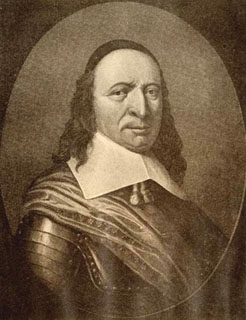| Peter Stuyvesant  Born: c. 1592 Born: c. 1592
Birthplace: Scherpenzeel, Friesland, Netherlands
Died: Feb-1672
Location of death: New York City
Cause of death: unspecified
Remains: Buried, St. Mark's Church, Manhattan, NY
Gender: Male
Race or Ethnicity: White
Occupation: Government Nationality: Netherlands
Executive summary: Dutch colonial governor Dutch colonial governor, born in Scherpenzeel, in southern Friesland, in 1592, the son of a minister. He studied at Franeker, entered the military service in the West Indies about 1625, and was director of the West India Company's colony of Curaçao from 1634 to 1644. In April 1644 he attacked the Portuguese island of Saint Martin and was wounded; he had to return to Holland, and there one of his legs was amputated. Thereafter he wore a wooden leg ornamented with silver bands. In May 1645 he was selected by the West India Company to supersede William Kieft as director of New Netherland. He arrived in New Amsterdam (later New York City) on the 11th of May 1647, and was received with great enthusiasm. In response to the demand for self-government, in September 1647 he and the council appointed -- after the manner then followed in Holland -- from eighteen representatives chosen by the people a board of nine to confer with him and the council whenever he thought it expedient to ask their advice; three of the nine, selected in rotation, were permitted to sit with the council during the trial of civil cases; and six were to retire each year, their successors to be chosen by the director and council from twelve candidates nominated by the board. The leading burghers were, however, soon alienated by his violent and despotic methods, by his defense of Kieft, and by his devotion to the interests of the company; the nine men became (as early as 1649, when they sent the famous Vertoogh, or Remonstrance, to the states-general asking for burgher government and other reforms) the center of municipal discontent; and a bitter quarrel ensued. In 1650 the states-general suggested a representative government to go into effect in 1653, but the company opposed it; in 1653, however, there was established the first municipal government for the city of New Amsterdam modelled after that of the cities of Holland. Stuyvesant also aroused opposition through his efforts to increase the revenues of the company, to improve the system of defense, and to prevent the sale of liquor and firearms to the Indians, and through his persecution of Lutherans and Quakers, to which the company finally put an end. He had a bitter controversy with the patroon of Rensselaerwyck, who claimed to be independent of the West India Company. In 1647 he seized a Dutch ship illegally trading at New Haven and claimed jurisdiction as far as Cape Cod; the New Haven authorities refused to deliver to him fugitives from justice in Manhattan; he retaliated by offering refuge to runaways from New Haven; but finally he offered pardon to the Dutch fugitives and revoked his proclamation. In September 1650 he came to an agreement with the commissioners of the United Colonies of New England at Hartford upon the boundary between New Netherland and Connecticut, involving the sacrifice of a large amount of territory, the new boundary crossing Long Island from the west side of Oyster Bay to the Atlantic Ocean, and on the mainland north from a point west of Greenwich Bay, 4 miles from Stamford. On Long Island, during Stuyvesant's rule, Dutch influence was gradually undermined by John Underhill. Stuyvesant's dealings with the Swedes were more successful. With a force of seven hundred men he sailed into the Delaware in 1655, captured Fort Casimir (Newcastle) -- which Stuyvesant had built in 1651 and which the Swedes had taken in 1654 -- and overthrew the Swedish authority in that region. He also vigorously suppressed Indian uprisings in 1655, 1658 and 1663. In March 1664 King Charles II granted to his brother, the Duke of York, the territory between the Connecticut river and Delaware Bay, and Colonel Richard Nicolls with a fleet of four ships and about three or four hundred men was sent out to take possession. Misled by instructions from Holland that the expedition was directed wholly against New England, Stuyvesant made no preparation for defense until just before the fleet arrived. As the burghers refused to support him, Stuyvesant was compelled to surrender the town and fort on the 8th of September. He returned to Holland in 1665 and was made a scapegoat by the West India Company for all its failings in New Amsterdam; he went back to New York again after the treaty of Breda in 1667, having secured the right of free trade between Holland and New York. He spent the remainder of his life on his farm called the Bouwerie, from which the present "Bowery" in New York City takes its name. He died in February 1672, and was buried in a chapel, on the site of which in 1799 was erected St. Mark's Church. An elite school, Stuyvesant High School in New York City, is named for him.
Governor of New Netherland (1646-64)
Surrendered to Enemy 1664
Risk Factors: Amputee
Do you know something we don't?
Submit a correction or make a comment about this profile
Copyright ©2019 Soylent Communications
|